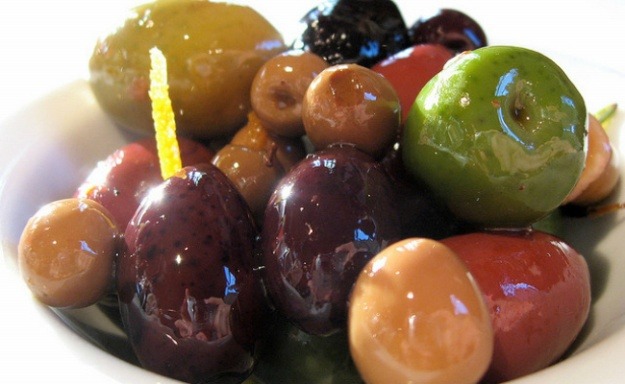Need some guidance when reaching for the bottle of olive oil? We’ve got you covered! Below is a comprehensive olive oil guide: the facts, the myths, the process of extraction, a brief look into the varieties of olive oil available, and of course, how to store and use extra virgin olive oil.
A great quality extra virgin olive oil is something that every modern (and not-so-modern) kitchen should have handy. It’s perfect to add easy flavor to dishes, great for dipping, to create sauces (see our Chimichurri recipe below) and also amazing for baking (try Food52′s amazing Olive Oil Cake recipe and you’ll be forever converted). It’s also great for our health, rich in antioxidants and monounsaturated fatty acids – healthy fats.
Extra Virgin Olive Oil
This is the top quality, top grade of olive oils. Extra virgin olive oil has cero defects, plus the highest levels of antioxidants AND the best flavor. To qualify as Extra Virgin, it must pass a series of strict quality tests set forward by the International Olive Council, including rigorous taste tests that look for a specific flavor profile, like enough olive fruitiness.
Pure Olive Oil / Light Olive Oil
Pure olive oil is oil with flavor or aesthetic “defects”, and has been further refined to remove those flaws. It is sometimes blended with EVOO for flavor. It’s not actually light as in calories or fat, but rather in looks and taste. You can use this for high-temp cooking, but you won’t be getting that characteristic olive taste.
The Extra Virgin Olive Oil Process & The Myth of the “First Cold Press”
First cold press just means that the olive oil comes from one press, which is the standard nowadays. The term is a throwback to the early days of olive oil production, where the second press of the olives produced a lower quality oil that was used for other purposes – like oil lamps. Today, all olive oil is first pressed, but the term endures as a marketing label. In short: Extra Virgin Olive Oil is, by definition, always both first and cold pressed.
To extract the top quality olive oils, the olives are crushed at a mill, then the oil extracted by mechanical means – a centrifugal machine. Refined oils are extracted by using chemical means or heat, which can greatly affect the flavor of the oils. Extra virgin olive oil is NEVER refined.
Tasting Extra Virgin Olive Oil
To truly understand olive oil, you have to think of it like wine and consider three things: varietal, terroir and timing.
Olive Oil Varietals

Photo: Steve Juvetson
There are many varietals (types) of olives, each with their different flavor profiles and characteristics, which will make for different kinds of olive oil. Some are bitterer, some are milder, and some even are sweet.There are hundreds of olive types from around the world, but only a few are used for olive oil productions. Below is handy olive oil guide to the most common ones:
Arbequina: originally from Catalonia, Spain, the flavor of this olive is delicate and very fruity. The olive oil it produces is great for pesto, baking, drizzled over meats. Arbequina olives are grown very successfully in California.
Frantoio: hailing from Tuscany, this olive makes for a strong, peppery olive oil with some bitterness.
Picual: a type of olive from Andalusia, Spain, the olive oil from Picual olives is strong, robustly peppery with floral aromas.
Taggiasca: mild, fruity, sweet with no bitterness. Taggiasca olive oil is buttery and versatile.
Hojiblanca: Another great Spanish olive cultivar, Hojiblanco is fruity, lightly spicy and just mildly bitter. Health bonus: It has lower saturated fats than most other oils.
Arbosana: A Spanish olive, Arbosana is also grown predominantly in California. Arbosana olive oil is robust, complex, and a bit nutty
Olive Oil & Terroir
Terroir is a French word speaks of the character of the land and the region, and how that translates into anything that grows in it: the soil conditions, the air, the weather…all these factors make the terroir, and therefore how the oil will taste. An extra virgin olive oil from California will be different than one from Italy, even if it is from the same olive, much like a Pinot from Chile will be different than one from France.
TIMING THE HARVEST
How soon or how late the olives are harvested will also influence the flavor of the oil – an early harvest will produce a more herbaceous olive oil, while latter harvest will make for a mellower, more buttery olive oil.
STORING EXTRA VIRGIN OLIVE OIL
We are so used to thinking about oil as a pantry item, because it needs no refrigerating, that we think: it must last forever, right? Wrong! Olives are after all fruit, and olive oil is really a kind of fruit juice, so to speak. So unlike vinegar, it won’t keep forever, and, unlike wine, it won’t get better with age. Here’s how to make the most of your green gold.
Shelf life of olive oil
Once it’s been bottled, olive oil has about a two-year shelf life. To maximize the flavor and benefits, try to use yours within 2 to 3 months of opening.
Storing olive oil
Store olive oil away from direct light and high temperature. A dark, cool cabinet is best.
Olive oil is typically bottled in dark, opaque bottles to minimize the exposure to UV rays but try to keep it away from the stove or oven or the window.
Loved our olive oil guide and ready to shop? We have a great selection of premium olive oils! Shop >